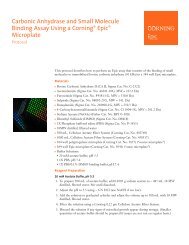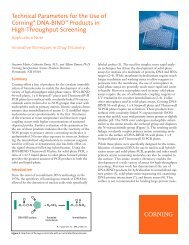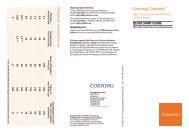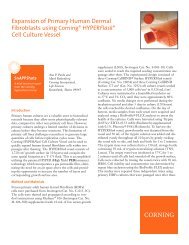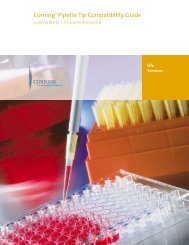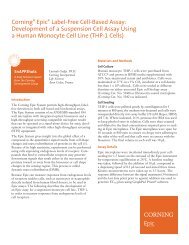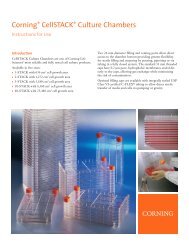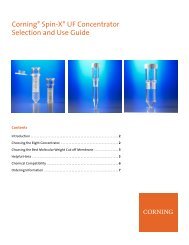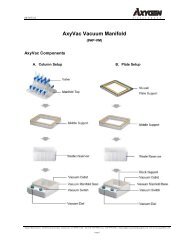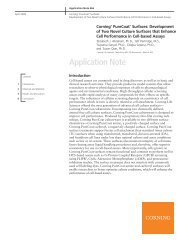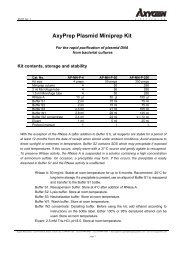Q4_Test_Epic Cell based SS.qxd - Corning Incorporated
Q4_Test_Epic Cell based SS.qxd - Corning Incorporated
Q4_Test_Epic Cell based SS.qxd - Corning Incorporated
Create successful ePaper yourself
Turn your PDF publications into a flip-book with our unique Google optimized e-Paper software.
Achieving Similar Quality Results with<br />
Lower Amounts of Protein in <strong>Corning</strong> ® <strong>Epic</strong> ®<br />
Biochemical Assays<br />
SnAPPShots<br />
A brief technical report<br />
from the <strong>Corning</strong><br />
Development Group<br />
Thomas Bunch and Alice Gao<br />
<strong>Corning</strong> <strong>Incorporated</strong><br />
Life Sciences<br />
Kennebunk, Maine<br />
Introduction<br />
For many laboratories, procuring, manufacturing, or purifying<br />
large quantities of a purified protein to perform a highthroughput<br />
label-free biochemical assay can be problematic.<br />
As a result, the following work was performed to demonstrate<br />
the validity and versatility of using lower amounts of<br />
protein when performing a biochemical screen using the<br />
<strong>Corning</strong> <strong>Epic</strong> Technology, a label-free detection system that<br />
uses ANSI/SBS standard 384 well microplates. The <strong>Epic</strong><br />
technology enables the detection of molecules binding directly<br />
to an immobilized target without the use of fluorescent<br />
or radioactive tags. Typically in a label free assay, protein or<br />
peptides are immobilized on the surface of each well in a<br />
microplate. This is a critical step because the immobilization<br />
level of proteins or peptides often determines the signal level<br />
of binding events, especially for molecules below 300 Daltons.<br />
The higher the immobilization level of protein, the higher<br />
the corresponding signal of binding events. To achieve a high<br />
immobilization level, the amount of protein required can<br />
sometimes become an issue. For example, immobilization<br />
levels of 2,000 picometers (pm) or above are considered<br />
reasonable for detecting small molecule binding. This<br />
immobilization level is usually achieved by using a concentration<br />
of 50 µg/mL protein in 15 µL of buffer. This<br />
requires the use of 750 ng of protein per well with a total<br />
of 288 µg per plate. Depending on the protein, this amount<br />
can be difficult or expensive to obtain.<br />
In this study, a strategy was developed to reduce the amount<br />
of protein required while maintaining an immobilization<br />
level that provides robust results in the <strong>Epic</strong> biochemical<br />
assay described. Proteins with a wide range of pI values were<br />
included in this study to demonstrate the versatility of this<br />
approach.<br />
Materials and Methods<br />
Reagents<br />
All proteins, including trypsin (Cat. No. T0303), streptavidin<br />
(Cat. No. S4762), carbonic anhydrase (Cat. No. C2522),<br />
lysozyme (Cat. No. L6876) and papain (Cat. No. P4762)<br />
were obtained from Sigma-Aldrich. Each of these proteins<br />
were made into stock solutions containing 5 mg/mL, dispensed<br />
into aliquots and kept frozen at -20°C prior to any<br />
experiments in the following buffers. For trypsin, streptavidin<br />
and carbonic anhydrase, optimal immobilization was<br />
achieved with 20 mM sodium acetate buffer (Thermo-<br />
Fisher, Cat. No. BP333-500) at pH 5.5, 5.5 and pH 5.1,<br />
respectively. For lysozyme and papain, optimal immobilization<br />
was achieved with 20 mM sodium phosphate at pH 8.0<br />
(Sigma, Cat. No. 82593). Phosphate buffered saline (PBS),<br />
pH 7.4, was used for washing the plates and was purchased<br />
from Sigma (Cat. No. P3813).<br />
Assay Procedure:<br />
All immobilizations were performed overnight at 4°C in<br />
<strong>Epic</strong> biochemical microplates (<strong>Corning</strong>, Cat. No. 5041)<br />
covered with foil. Protein was added to the wells of each<br />
microplate using a Matrix Impact 2 16-channel automated<br />
pipettor (Cat. No. 2061). After overnight immobilization,<br />
plates were washed using a Biotek ELx405 TM plate washer<br />
with PBS, pH 7.4. After washing, 15 µL of PBS/0.1%<br />
DMSO was added to each well, and the immobilization<br />
levels were measured using the <strong>Epic</strong> ® reader.<br />
Data Analysis<br />
The graphs were plotted using GraphPad Prism software.
Results<br />
The first approach for minimizing the amount of immobilized<br />
protein required to perform the assay was to reduce<br />
the volume of the protein solution added to each well. The<br />
immobilization levels of three frequently used proteins (carbonic<br />
anhydrase, streptavidin and trypsin) using different<br />
protein sample volumes per well were compared, while<br />
keeping the protein sample concentrations consistent at 50<br />
µg/mL. The optimal immobilization pH values of 5.5, 5.5<br />
and 5.1 were used for carbonic anhydrase (CA), streptavidin<br />
(SA) and trypsin, respectively. As summarized in Figure 1A,<br />
there is a corresponding drop in immobilization levels of<br />
approximately 20% for all three proteins when the volume<br />
was reduced from 15 µL to 5 µL at the standard protein<br />
concentration of 50 µg/mL. Therefore, a simple reduction<br />
in protein sample volume is not a viable solution to reduce<br />
protein consumption.<br />
In the following test the protein concentration was increased<br />
from 50 µg/mL to 75 µg/mL and the volume decreased for<br />
addition to the well was evaluated an alternative method for<br />
reducing the protein required to perform the assay. As shown<br />
in Figure 1B, the slight increase in protein concentration to<br />
75 µg/mL resulted in more consistent immobilization levels<br />
across all volumes tested when compared to the results<br />
achieved using 50 µg/mL protein concentration. A small<br />
immobilization decrease of ~10% was observed using 5<br />
µL/well as compared to 15 µL/well. A similar trend was<br />
observed for all 3 proteins tested. A one sample t-test was<br />
performed for each protein, comparing the immobilization<br />
signals obtained from the standard condition with 15 µL of<br />
50 µg/mL protein (equal to 750 ng per well protein consumption)<br />
and those from the new condition with 5 µL of<br />
75 µg/mL (equal to 375 ng per well protein consumption).<br />
The results showed that there is no significant difference<br />
between the immobilization levels obtained under these two<br />
conditions (t [24] 0.05). These results suggest that a<br />
strategy of reducing volume while increasing protein concentration<br />
slightly is a viable option for controlling protein<br />
consumption.<br />
The three proteins tested above all require low pH for<br />
immobilization. To better understand whether the approach<br />
to optimize protein binding would apply to all proteins, two<br />
proteins that typically require high pH for immobilization,<br />
papain and lysozyme, were evaluated in a similar approach.<br />
The optimal immobilization for these two proteins typically<br />
is observed at pH 8.0. Therefore, sodium phosphate buffer<br />
was used to dilute the proteins to concentrations of 75 µg/mL<br />
and 50 µg/mL. Volumes of 15, 10 and 5 µL/well were evalu-<br />
A. B.<br />
Figure 1. Comparison of protein immobilization levels (pm) of carbonic anhydrase (CA), streptavidin (SA) and trypsin after the addition of either 15, 10 or<br />
5 µL protein solution at either (A) 50 µg/mL protein concentration or (B) 75 µg/mL protein concentration. The standard assay protocol recommends<br />
15 µL of 50 µg/mL protein solution to be added to each well during the immobilization ste, which is equivalent to 750 ng total protein used per well.<br />
Results are representative of 3 independent experiments (N = 24).
A. B.<br />
Figure 2. Comparison of protein immobilization levels (pm) of papain or lysozyme after the addition of either 15, 10 or 5 µL protein solution at either<br />
(A) 50 µg/mL protein concentration or (B) 75 µg/mL protein concentration. Results are representative of 3 independent experiments (N = 24).<br />
ated as described and the results are summarized in Figure 2.<br />
For papain, the observed trend was similar to the proteins<br />
that require acidic pH for immobilization. The immobilization<br />
level at the reduced volume of 5 µL was equivalent to<br />
that at the standard volume of 15 µL when the protein<br />
concentration was increased from 50 µg/mL to 75 µg/mL.<br />
Lysozyme, on the other hand, did not follow this trend. A<br />
significant reduction in the immobilization level was observed<br />
when the volume was reduced from 15 µL to 5 µL regardless<br />
of the lysozyme protein concentration. Reducing the<br />
volume from 15 to 10 µL for this protein gave a similar<br />
signal (data not shown), suggesting that it is possible to<br />
still achieve quality results while conserving protein.<br />
Conclusions<br />
This study demonstrates that similar <strong>Epic</strong> ® label-free assay<br />
results can be achieved by using 50% less protein during<br />
the immobilization step compared to the standard protocol.<br />
The 50% reduction in protein consumption was achieved<br />
by lowering the volume used during immobilization from<br />
15 µL to 5 µL while simultaneously increasing the concentration<br />
of the protein immobilized from 50 µg/mL to<br />
75 µg/mL. This approach works well for 3 proteins that require<br />
a low or high pH for immobilization and for 1 of the 2<br />
proteins that require high pH conditions for immobiliation,<br />
leading to reduced protein consumption needed to run an<br />
<strong>Epic</strong> biochemical assay.
For additional product or technical information, please visit www.corning.com/lifesciences<br />
or call 1.800.492.1110. Outside the United States, please call 978.442.2200.<br />
<strong>Corning</strong> <strong>Incorporated</strong><br />
Life Sciences<br />
Tower 2, 4th Floor<br />
900 Chelmsford St.<br />
Lowell, MA 01851<br />
t 800.492.1110<br />
t 978.442.2200<br />
f 978.442.2476<br />
www.corning.com/lifesciences<br />
Worldwide<br />
Support Offices<br />
A S I A / P A C I F I C<br />
Australia/New Zealand<br />
t 0402-794-347<br />
China<br />
t 86 21 2215 2888<br />
f 86 21 6215 2988<br />
India<br />
t 91 124 4604000<br />
f 91 124 4604099<br />
<strong>Corning</strong> and <strong>Epic</strong> are registered trademarks of <strong>Corning</strong> <strong>Incorporated</strong>, <strong>Corning</strong>, NY.<br />
All other trademarks in this document are the property of their respective owners.<br />
<strong>Corning</strong> <strong>Incorporated</strong>, One Riverfront Plaza, <strong>Corning</strong>, NY 14831-0001<br />
Japan<br />
t 81 3-3586 1996<br />
f 81 3-3586 1291<br />
Korea<br />
t 82 2-796-9500<br />
f 82 2-796-9300<br />
Singapore<br />
t 65 6733-6511<br />
f 65 6861-2913<br />
Taiwan<br />
t 886 2-2716-0338<br />
f 886 2-2516-7500<br />
E U R O P E<br />
France<br />
t 0800 916 882<br />
f 0800 918 636<br />
Germany<br />
t 0800 101 1153<br />
f 0800 101 2427<br />
The Netherlands<br />
t 31 20 655 79 28<br />
f 31 20 659 76 73<br />
United Kingdom<br />
t 0800 376 8660<br />
f 0800 279 1117<br />
All Other European<br />
Countries<br />
t 31 (0) 20 659 60 51<br />
f 31 (0) 20 659 76 73<br />
L AT I N A M E R I C A<br />
Brasil<br />
t (55-11) 3089-7419<br />
f (55-11) 3167-0700<br />
Mexico<br />
t (52-81) 8158-8400<br />
f (52-81) 8313-8589<br />
© 2011 <strong>Corning</strong> <strong>Incorporated</strong> Printed in U.S.A. 8/11 POD CLS-AN-166



